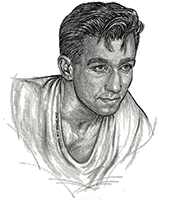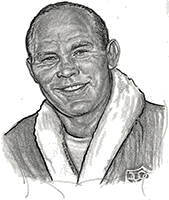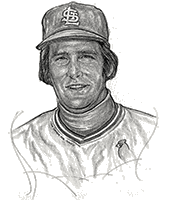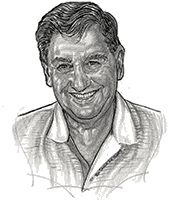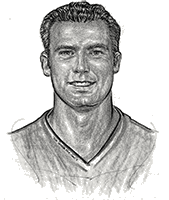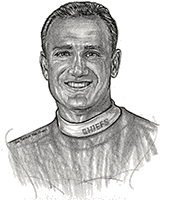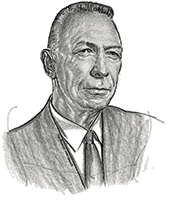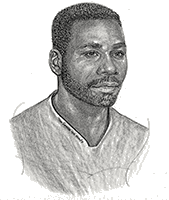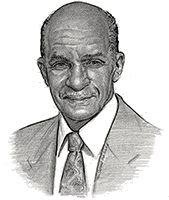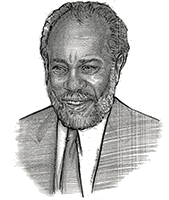In the post World War II years, East Tech dominated the Cleveland high school track scene and Baldwin-Wallace was easily the kingpin among the local college thinclads. One of the key contributors to their dominance was Ted Theodore. Running the 440 and 880 and on record-breaking mile and two-mile relay teams for legendary East Tech Coach Ivan Greene, he captained the Scarabs to the 1946 city title and a second place finish in the Ohio state championships. The two relays completely dominated their competition, winning blue ribbons in the Cleveland Indoor Senate meet, the West Tech and Ohio Wesleyan Relays and the district meet en route to their pair of state titles. Theodore added to his high school laurels by winning the 440 at the National Junior Olympic Championships run at Municipal Stadium, and collecting additional gold as a member of the meet’s winning mile relay. Moving on to B-W, he would win All-Ohio championships in the 440, 880 and mile relay four straight years and captain the 1950 team. Entering the Army, he coached and captained the Ft. Knox team to two runner-up finishes in the 2nd Army Championships. After returning to civilian life, he devoted several years to coaching cross country and track teams at Berea, Midpark and Euclid High Schools, winning a multitude of championships. Theodore served in a variety of administrative and service roles subsequently in the Euclid Schools and community and also for Baldwin-Wallace, he nevertheless remained active in the track world as a registered OHSAA track official for high school and college for 45 years and served as the announcer for the Knights of Columbus Track Meet for 20 years. Ostensibly retired, he continues to officiate track and makes his home in Euclid.
There are records and there are DiMaggio’s 56 and Cy Young’s 511; the virtually untouchables. And then there is Pete Rademacher’s mark. It will never be beaten. The best anyone could ever do is match it. After winning the 1956 Olympic heavyweight boxing champion, Pete became the first, and still only, boxer in history to fight for the championship of his division in his first professional match. There is no fairytale ending to the story; although he was knocked down in the second round, defending champion Floyd Patterson bounced up to win on a 6th round TKO in their 1957 bout. But the fact that the match took place at all is still a topic of wonder among fight fans. So, for that matter, is Rademacher. A star varsity boxer and two-year football starter at Washington State in 1950-51, he was not without experience as an amateur, winning four Seattle Golden Gloves titles, the U.S. Amateur Championship in 1953 and the Chicago Golden Gloves and All-Army and All-Service championships in 1956 before qualifying for the U.S. Olympic team. In Melbourne, he won all three of his Olympic bouts by knockout, earning the gold medal with a first round win over favored Russian opponent Lev Moukhine in a highly charged atmosphere. Soon after, he began negotiating for his improbable shot at the professional heavyweight crown. Amazingly, he was able to pull it off by enlisting backers to post a $250,000 guarantee. After the Patterson bout he would go on to fight 22 more times as a pro, winning 14 (8 by knockout) and losing 7 before retiring in 1962. Two of those bouts were at the Cleveland Arena and both ended in victory. Afterwards he went into business at Keifer-McNeil in Akron, retiring as its president in 1987, and frequently refereed boxing matches in Northeast Ohio. For over 40 years he has made his home in Medina.
Deceased 2020
In an era of great success for Euclid High baseball, Tom Murphy was one of its brightest stars, pitching the Panthers to the 1963 Class A Ohio state high school championship. He then moved on to Ohio University where over his sophomore and junior seasons he built a 16-1 record, helping the Bobcats to a pair of Mid-American Conference titles and winning second team All-American recognition at the close of the 1966 season. That earned him a berth on the national team coached by the legendary Rod Dedeaux of USC, which faced teams from Japan, Korea and the Philippines in Hawaii. More importantly, it would lead to his selection in the first round (sixth pick overall) in the secondary phase of the major league draft by the California Angels in January, 1967. He was sent to the Seattle Pilots immediately after his graduation in June and one year later he made his major league debut against the Boston Red Sox at Fenway Park to launch an 11-year career in the majors with the Angels, Kansas City, St. Louis, Milwaukee, Boston and Toronto. As a starter for the Angels from 1969-71, he averaged 226 innings per year, winning a career high 16 games in 1970. Converted to a reliever by Milwaukee in 1974, he won 10 games and saved 20 while compiling a 1.90 ERA in 70 games to earn Fireman of the Year honors, then recorded another 20 saves the following season. He ended his career in 1979 with 67 wins and 59 saves while pitching in 439 games. He is now following a career in Commercial Real Estate in Southern California, specializing in Tenant Representation. He makes his home in Coto de Caza, CA with his wife Kriss.
It was supposed to be a one-year fling when Merle Levin walked into the converted barbershop which was the office for the Fenn College Athletic Department in 1955, found a typewriter, and assumed the part-time duties of the school’s first sports publicist. Somehow the Glenville High grad, an ex-sports editor of the University of Michigan Daily, needed 38 years to get the sports writing bug out of his system. The part time sports publicity job evolved into a full time post as Administrative Assistant to the Athletic Director when the state transformed Fenn into Cleveland State University in 1964. He became the department’s utility man, handling the duties of numerous jobs yet to be filled by the understaffed office. Later he would play an active role in helping to form a mid-major athletic conference, the Mid-Continent, for CSU teams to play in, paving the way to compete for berths in NCAA and NIT basketball tourneys. Along the way, Levin triggered the start-up of the school’s first endowed athletic scholarships, helped create CSU’s Athletic Hall of Fame, and filled advisory roles in the planning of CSU’s Physical Education Center and acclaimed Convocation Center. He also made time as Sports Information Director to oversee media activities for five NCAA National Swimming and Diving Championships hosted by CSU, plus numerous regional tournaments in basketball, soccer, and wrestling and to produce several team publications named best in nation by his peers while his job title morphed into Assistant Athletic Director. Calling it a career in 1992, he became Executive Director of SMACO (Sports Media Association of Cleveland and Ohio), helping to raise nearly $500,000 for charity in the next decade. He and his wife, Dolores, make their home in Gates Mills.
Deceased 2009
One of a mere handful of Northeastern Ohio native sons to ever star in the National Hockey League, Parma-born Brian Holzinger launched his career in this area’s increasingly productive high school program, leading Padua Franciscan High to a pair of Ohio state high school championships in 1988 and 1989. After piling up 72 goals and 65 assists for 137 points in just 35 games, he honed his game for two years in Junior A hockey in Detroit before enrolling at Bowling Green State University in 1991. He netted 14 goals and 8 assists as a BGSU freshman and also earned a berth on the U.S. Junior National team that won the bronze medal in the 1992 World Junior Hockey Association Tournament. He became a second team CCHA All-Star as a sophomore and as a senior his 35 goals and 68 total points earned him first team CCHA All-Star and Player-of-the Year plaudits and NCAA West First Team All-American honors, and culminated with his selection for the 1995 Hobey Baker Award as the top collegiate player in the United States. Picked by the Buffalo Sabres as the 124th selection in the 1991 NHL Entry Draft, he made his NHL debut in April 1995, scoring two goals and an assist in four playoff games. He continued to play for the Sabres through 2000, enjoying his best years in 1996-97 with 51 pts. (22-29) in 81 games and 1998-99 when he helped the team to the Stanley Cup finals. Traded to Tampa Bay in March, 2000, he later played with Pittsburgh and Columbus, retiring at the end of the 2003-04 season having scored 93 goals and 145 assists in 547 games. He currently lives in Broadview Heights.
It was apparent soon after Elvis Grbac arrived at St. Joseph High School that the storied athletic power on the shores of Lake Erie had landed another special talent. The sturdy 6-5 youngster made his first impact in basketball, then added football to his resume in his junior year in 1987. Although playing in a run-oriented offense featuring a remarkable talent named Desmond Howard, he attracted enough attention on the gridiron to earn honorable mention All-Ohio honors and a decade later would become the first Viking athlete to be honored by having his numbers retired in two sports- #12 in football and #53 in basketball. Originally interested in continuing his football career at Ohio State, he changed his mind when the Buckeyes fired Head Coach Earl Bruce and opted instead to join teammate Howard at Michigan. As a four-year starter for the Wolverines, Grbac led them to four Big 10 titles, leading the conference in passing in 1990, 1991 and 1992 while setting nine Michigan passing records. Drafted by the San Francisco 49ers in 1994, he served as the backup to Steve Young on a Super Bowl championship team in his rookie season. Elvis went on to play seven more seasons, starting 69 of the 106 games he played for San Francisco (1994-96), Kansas City (1997-2000) and Baltimore (2001). He currently makes his home in Chagrin Falls.
In the middle of the 20th century, the thriving metropolis of Cleveland, with three daily newspapers bearing its name on their mastheads, was blessed with a coterie of sportswriter/columnists who could coax the keys of their typewriters to produce the news, the insights, the drama, the joys and the sorrows of their special world with the very best in the nation. Among this special group was the man whose somber face graced the top of a regular column entitled “Plain Dealing”, the man seemingly known to everyone simply as Cobby. Gordon Cobbledick was the sports editor of the Plain Dealer from 1946 until his retirement in 1964. Before that he had covered the Cleveland Indians for 25 years with his signature story perhaps being the news of the team’s rebellion against manager Oscar Vitt in 1940. Shortly thereafter he would turn war correspondent, writing from the Pacific Theatre during World War II, then returning to become PD sports editor soon after. During his long career he served a term as president of the Baseball Writers Association of America and in 1977, nine years after his death, he would become the first Ohio writer to be inducted into the writers wing of the Baseball Hall of Fame in Cooperstown. Another posthumous honor would come his way in 1982 when he was inducted into the Journalism Hall of Fame. Born in Cleveland, Cobby was the holder of a masters degree in mining engineering from Case Tech, where he starred in football. He continued to make the city his home until moving to Tucson, AZ shortly before his death in 1969.
(Deceased)
As a 6-6 250 pound defensive lineman, NFL scouts would probably toss him back into the deep end of the talent pool today. But when Al Baker came out of Colorado State University as a two-time all-conference choice in both football and basketball, the Detroit Lions were only too happy to reel him in as their No. 2 pick, the 40th choice overall in the 1978 draft. He repaid their confidence with a spectacular inaugural season, leading the NFL with 23 quarterback sacks, (the first of five consecutive years he would top the league in that category), and earning Defensive Rookie of the Year, Lineman of the Year, and first team All-Pro laurels. Two more All-Pro seasons would follow during his five years with the Lions. Traded by Detroit to St. Louis, he spent four season with the Cardinals, then was traded to Cleveland in 1987, left to join the Minnesota Vikings in 1988 and returned to the Browns for the 1989 and 1990 seasons. During his 13-year pro career, he was credited with 148.5 sacks and in 2004 he was picked by Sports Illustrated as the ninth Greatest Pass Rusher in NFL history. When he retired after the 1990 season, the Florida native and one-time New Jersey high school star elected to remain in Cleveland, stressing an affinity for the area and its residents. He settled in Avon where he owns and operates Bubba Q’s Restaurant and Catering. The restaurant won several “Best in Cleveland” awards and has also developed a reputation for feeding the homeless. He and his wife Sabrina are the parents of two children, Brittany Bo and James Landon.
One of the most successful college basketball coaches of all time, with a record of 523-126, John McClendon, Jr. is enshrined in the National Basketball Hall of Fame. His milestone 500th victory came at Cleveland State where he coached from 1966-69. Earlier he coached the Cleveland Sweeny Pipers (1959-61) to NIBL and national AAU championships. John learned the game as a student of its creator, Dr. James B. Naismith, at the University of Kansas. Won an unprecedented three consecutive NAIA titles at Tennessee State. Also coached at Hampton Institute, North Carolina Central, Kentucky State and the professional Denver Rockets of the ABA, and served on the coaching staffs of three U.S. Olympic teams. After 21 years as a national and international basketball consultant, he returned to Cleveland in 1991 and became a special assistant to the athletic director of Cleveland State and is a Professor in the University’s Black Studies program.
For more than 40 years, Clinton Martin has trained amateur boxers on the local, national and international levels, tutoring some of Cleveland’s finest pugilistic products. Among them were Jeff Stoudemire, 1978 Golden Gloves champion and 1979 national AAU champion and Golden Gloves titlists Henry Hughes (1981), Sanderline Williams (1982) and Todd Hickman (1982 and 1983). Twice he was selected to coach USA amateur teams against the national teams of Cuba and Russia. Since 1990 he has served Cleveland as Commissioner of Boxing and Wrestling and in 1996 he was elected vice president of the local governing body, ABA of the USA, for the Northwestern Counties of Ohio.
2001 Crocker Rd., Ste. 510, Westlake, OH 44145
Phone: 216-241-1919

